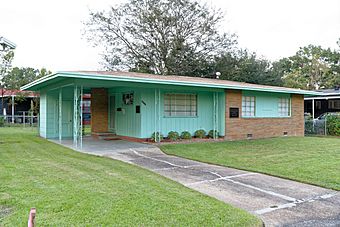Medgar and Myrlie Evers Home National Monument facts for kids
|
Medgar and Myrlie Evers Home National Monument
|
|
|
U.S. Historic district
Contributing property |
|

2018 photo
|
|
| Location | 2332 Margaret Walker Alexander Drive, Jackson, Mississippi |
|---|---|
| Area | less than one acre |
| Built | 1956 |
| Built by | Leroy Burnett |
| Architectural style | Ranch |
| Part of | Medgar Evers Historic District (ID13000737) |
| NRHP reference No. | 000001459, 100000791 |
Quick facts for kids Significant dates |
|
| Added to NRHP | December 5, 2000 |
| Designated NHL | February 16, 2017 |
| Designated CP | September 18, 2013 |
The Medgar and Myrlie Evers Home National Monument is a special place in Jackson, Mississippi. It is also known as the Medgar Evers House. This historic house was built in 1956. It was the home of Medgar Evers, an important African-American civil rights leader. He lived here when he was sadly killed in 1963.
In 2017, this house was named a National Historic Landmark. This means it is a very important place in American history. On March 12, 2019, a law was passed to make it a national monument. It officially became a national monument on December 10, 2020. This happened after the National Park Service took ownership of the house.
Contents
A Home with History: The Medgar Evers House
The Medgar Evers House is located in northern Jackson. It is part of the Elraine Subdivision. This area was the first planned neighborhood for middle-class African-Americans in Mississippi. It was built after World War II.
The house is a single-story building made of wood. It has a low, sloped roof. It also has a carport, which is a covered area for parking a car. The main entrance to the house is under this carport. Some parts of the house are covered in brick. Other parts use a material called asbestos siding.
Why This House Was Chosen
Medgar and Myrlie Evers bought this house in 1956. They lived there until 1963. Both Medgar and Myrlie were very active in the civil rights movement. This movement worked for equal rights for all people. Because of their work, they were often targets of violence.
They chose this house partly because it offered more safety. It was not on a corner lot. The entrance under the carport also gave them better protection.
A Tragic Event at Home
The Evers family faced many dangers. On May 28, 1963, someone threw a Molotov cocktail (a type of firebomb) onto their carport.
Just a few weeks later, on June 11, 1963, Medgar Evers attended a meeting. This meeting was about stopping George Wallace, the Governor of Alabama, from blocking African-Americans from attending the University of Alabama.
Around midnight, Medgar Evers came home. As he stood in his carport, he was shot. The bullet went through a window and a wall inside the house. Medgar Evers died early the next morning.
Preserving a Landmark for the Future
After Medgar's death, Myrlie Evers moved to California in 1964. She continued her important work in the civil rights movement. She kept ownership of the house for 30 years. During this time, she rented it out to others.
In 1993, Myrlie Evers gave the house to Tougaloo College. The house was repaired and made stable in 1995-1996. In 2013, it was restored to look just as it did when the Evers family lived there. This helps us remember their bravery and the fight for civil rights.



